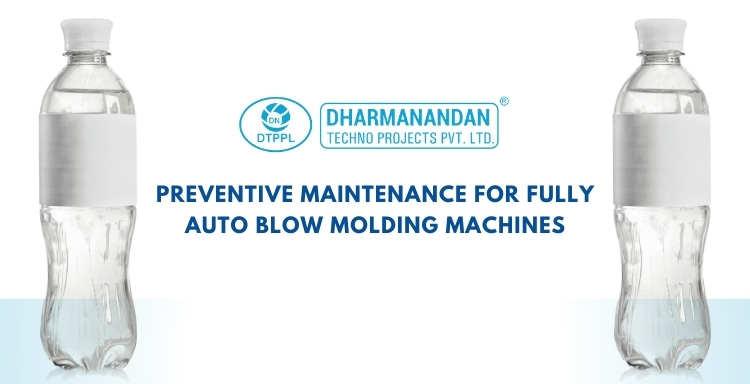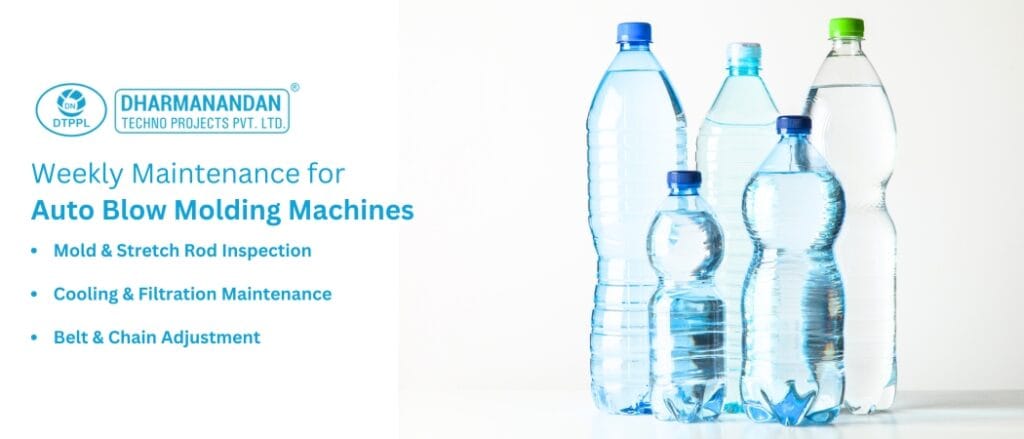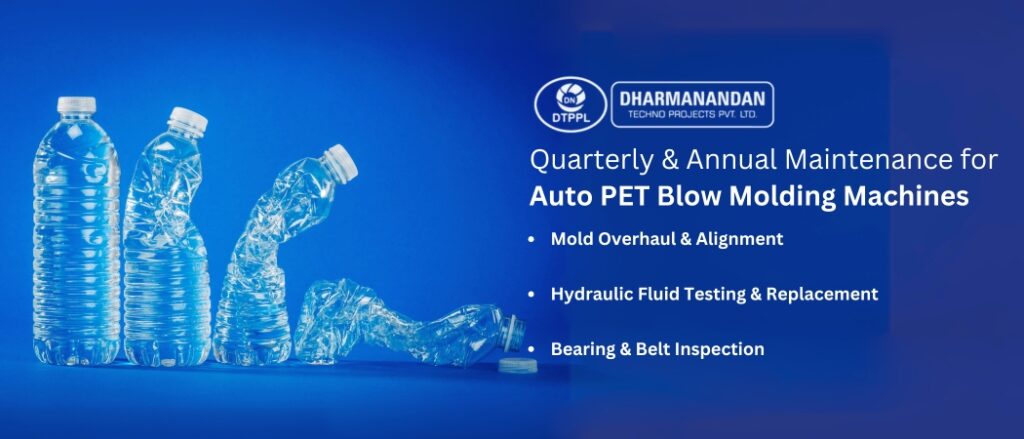
Table of Contents
Preventive Maintenance for Fully Auto Blow Molding Machines
March 19, 2025
The steady hum of a fully auto blow molding machine is a sign of a well-functioning production line. It transforms preforms into perfect bottles with precision and speed. But when a minor issue goes unnoticed, that hum can turn into a deafening silence, bringing operations to a sudden halt. A single malfunction can lead to production delays, wasted material, and financial losses.
Now, imagine a different scenario. The same blow moulding machine, running flawlessly, producing uniform bottles day after day. No unexpected breakdowns, no emergency repairs, just consistent performance. This is the power of preventive maintenance—a proactive approach that not only keeps the machine running but also ensures efficiency, quality, and cost savings.
In this guide, we will take a step-by-step approach to preventive maintenance, focusing on practical, hands-on tasks that can help you achieve uninterrupted production and longer machine life.
Understanding the Risks of Neglecting Maintenance in Blow Molding Machines

Every blow molding operator has faced issues that seem to arise out of nowhere—bottles with uneven walls, improper stretching, air leaks, or overheating. These issues don’t happen randomly; they are usually the result of poor maintenance practices.
The most common reasons for machine failures include:
- Preform heating issues – Uneven or insufficient heating leads to defective bottle shapes.
- Stretch rod misalignment – Bent or worn rods cause improper stretching.
- Mold cooling inefficiencies – Inadequate cooling results in warping and size variations.
- Compressed air contamination – Moisture and debris in air supply impact bottle formation.
- Hydraulic fluid degradation – Dirty or low-quality oil affects machine response.
- Electrical faults – Sensors, wiring, or PLC malfunctions disrupt operations.
- Belt and chain misalignment – Loose or worn belts reduce efficiency and cause slippage.
By recognizing these potential failures, you can prevent PET Blow Moulding Machine downtime before it occurs.
Developing an Effective Preventive Blow Molding Machine Maintenance Plan
A successful preventive maintenance plan requires consistency, data tracking, and trained personnel. Here’s how you can implement it in your daily Polyethylene Terephthalate Blow Moulding Machine operations.
Blow Moulding Machine Daily Maintenance Tasks: The First Line of Defense
The most effective way to prevent major failures is to conduct daily inspections. These tasks take only a few minutes but help detect early signs of wear and tear in Fully Automatic Blow Moulding Machine.
1. Visual Inspection
- Walk around the machine and check for oil leaks, loose bolts, or misaligned parts.
- Look for signs of dust, debris, or PET residue around the preform heating zone.
- Listen for unusual noises like grinding, hissing, or squealing.
- Check air pressure gauges and ensure the compressed air system is stable.
2. Cleaning and Lubrication
- Remove dust, preform residue, and excess lubricant from machine parts.
- Apply recommended lubricants to guide rails, stretch rods, and moving parts.
- Avoid over-lubrication, as excess grease can attract contaminants.
3. Heating and Air System Checks
- Ensure all infrared lamps are working and heating evenly.
- Measure preform temperature using an infrared thermometer.
- Drain water from air dryers and filters to prevent moisture build-up.
4. Safety System Testing
- Press emergency stop buttons to ensure they work instantly.
- Check safety interlocks—the Fully Automatic PET Blow Moulding Machine should not operate if doors are open.
Auto Blow Molding Machine Weekly Maintenance Tasks: Deepening the Inspection
In addition to daily checks, a weekly maintenance routine focuses on critical components.
1. Mold and Stretch Rod Inspection
- Clean the mold cavities to remove PET residue.
- Check for scratches, wear, or cracks in the mold.
- Inspect stretch rods for bends or rough movement.
- Lubricate stretch rods for smooth operation.
2. Cooling and Filtration Systems
- Clean compressed air filters to prevent contamination.
- Flush mold cooling channels to remove blockages.
- Inspect water flow in the cooling system.
3. Belt and Chain Adjustments
- Check for belt tension and signs of fraying.
- Align chains properly to prevent uneven wear.

Automatic Blow Molding Machine Monthly Maintenance: Ensuring Long-Term Performance
A deeper inspection is necessary every month to keep the machine at peak efficiency.
1. Hydraulic System Health Check
- Inspect hydraulic oil for discoloration, contamination, or foaming.
- Tighten hydraulic connections and look for leaks.
- Check for pressure stability in hydraulic circuits.
2. Electrical and Sensor Calibration
- Inspect electrical connections for loose wiring or burnt marks.
- Test temperature and pressure sensors for accurate readings.
- Use diagnostic software to analyze PLC and control system performance.
3. Cooling and Airflow Optimization
- Flush mold cooling channels with a descaling solution.
- Ensure chiller efficiency to maintain optimal cooling.
- Check for air leaks in the compressed air system.
Auto PET Blow Molding Machine Quarterly and Annual Maintenance: Extending Machine Life
Every three to six months, conduct major maintenance tasks to keep the PET Blow Molding Machine running efficiently.
1. Mold Overhaul and Alignment
- Disassemble and thoroughly clean mold components.
- Use precision measuring tools to check for size accuracy.
- Ensure mold venting systems are clear.
2. Hydraulic Fluid Testing
- Conduct viscosity and contamination tests on the oil.
- Change hydraulic fluid if it shows signs of degradation.
- Perform filtration improvements if contamination is high.
3. Bearing and Belt Replacement
- Replace worn-out belts and chains.
- Use vibration analysis tools to detect bearing wear.

Embracing Predictive Blow Moulding Machine Maintenance
While preventive maintenance keeps a Polyethylene Terephthalate Blow Molding Machine running, predictive maintenance takes it further by anticipating failures before they happen.
How does predictive maintenance work?
- IoT sensors track temperature, pressure, and vibration in real time.
- AI-based analytics detect patterns in machine performance.
- Augmented reality (AR) tools guide technicians with real-time maintenance instructions.
- Digital twin technology simulates Fully Automatic Blow Molding Machine performance for better troubleshooting.

Fully Automatic Blow Molding Machine
Capacity: 2400 BPH to 12000 BPH
Conclusion: A Commitment to Operational Excellence
Preventive maintenance isn’t just about keeping the Fully Automatic PET Blow Molding Machine running—it’s about ensuring consistent production, reducing costs, and extending machine life. A well-maintained fully auto blow molding machine delivers better bottle quality, fewer defects, and higher efficiency.
But maintenance is only effective if it’s executed consistently and correctly. Empower your team with the right tools, training, and data-driven insights to keep operations running smoothly.
Looking for a reliable partner for a semi auto blow molding machine or a water plant? DTPPL is a trusted manufacturer and supplier, offering cutting-edge solutions to keep your production line efficient and uninterrupted.
Contact us today to take your manufacturing performance to the next level.
About Author

Director – Global Marketing and Sales
Mr. Bhavesh from Dharmanandan Techno Projects Pvt. Ltd. has played a pivotal role in elevating the DTPPL brand to the global stage, leveraging his exceptional expertise in marketing and communications. He is committed to helping clients achieve significant growth while strengthening their own brands. Dharmanandan Techno Projects Pvt. Ltd. is a leading manufacturer and supplier of water purification systems and turnkey solutions for mineral water plants. With years of experience in designing and delivering high-quality water treatment solutions, the company provides end-to-end services, including system design, installation, maintenance, and ongoing support. Specializing in scalable and customizable water plants, DTPPL has successfully served industries worldwide, ensuring clean and safe drinking water across diverse applications.




